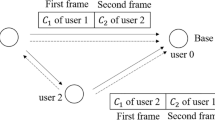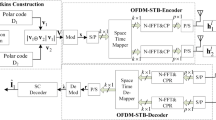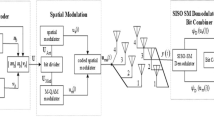Abstract
A spatial modulation scheme based on the multi-level construction of polar code is proposed and its performance over Rayleigh and Rician fading channels is evaluated. The spatial modulation exhibits antenna index transmission that inculcates an increased spectral efficiency in the proposed setup. Moreover, in the considered multi-level construction of polar code there exists a parallel built-in structure that enabled us to effectively extend the proposed polar coded spatial modulation scheme to cooperative scenarios. In order to check the usefulness of the proposed coded cooperative spatial modulation scheme, we have also developed a conventional polar coded cooperative nested scheme in the context of spatial modulation. Monte Carlo simulated results reveal that the proposed coded cooperative spatial modulation scheme outperforms the nested coded cooperative spatial modulation scheme under an identical conditions. The increased bit-error-rate performance of the proposed coded cooperative spatial modulation scheme is made possible due to effective deployment of the joint successive cancellation polar decoder at the destination node. Moreover, the proposed coded cooperative spatial modulation schemes outperform its coded non-cooperative counterpart schemes under identical conditions, as expected.







Similar content being viewed by others
References
Barry, J. R., Lee, E. A., & Messerschmitt, D. G. (2004). Digital communication. New York: Springer.
Foschini, G. J., & Gans, M. J. (1998). On limits of wireless communications in a fading environment when using multiple antennas. Wireless Personal Communications, 6(3), 311–335.
Wolniansky, P. W., Foschini, G. J., Golden, G. D., & Valenzuela, R. A. (1998). V-BLAST: An architecture for realizing very high data rates over the rich-scattering wireless channel. In ISSSE 98. 1998 URSI international symposium on signals, systems, and electronics, pp. 295–300.
Li, Q., Li, G., Lee, W., Lee, M. I., Mazzarese, D., Clerckx, B., et al. (2010). MIMO techniques in WiMAX and LTE: A feature overview. IEEE Communications Magazine, 48(5), 86–92.
Boccardi, F., Clerckx, B., Ghosh, A., Hardouin, E., Jngren, G., Kusume, K., et al. (2012). Multiple-antenna techniques in LTE-advanced. IEEE Communications Magazine, 50(3), 114–121.
Mesleh, R. Y., Haas, H., Sinanovic, S., Ahn, C. W., & Yun, S. (2008). Spatial modulation. IEEE Transactions on Vehicular Technology, 57(4), 2228–2241.
Yang, Y., & Jiao, B. (2008). Information-guided channel-hopping for high data rate wireless communication. IEEE Communications Letters, 12(4), 225–227.
Jeganathan, J., Ghrayeb, A., & Szczecinski, L. (2008). Spatial modulation: Optimal detection and performance analysis. IEEE Communications Letters, 12(8), 545–547.
Hwang, S. U., Jeon, S., Lee, S., & Seo, J. (2009). Soft-output ML detector for spatial modulation OFDM systems. IEICE Electronics Express, 6(19), 1426–1431.
Naidoo, N. R., Xu, H. J., & Quazi, T. A. M. (2011). Spatial modulation: Optimal detector asymptotic performance and multiple-stage detection. IET Communications, 5(10), 1368–1376.
Basar, E., Aygolu, U., Panayirci, E., & Poor, H. V. (2011). New trellis code design for spatial modulation. IEEE Transactions on Wireless Communications, 10(8), 2670–2680.
Mesleh, R., Di Renzo, M., Haas, H., & Grant, P. M. (2010). Trellis coded spatial modulation. IEEE Transactions on Wireless Communications, 9(7), 2349–2361.
Koca, M., & Sari, H. (2012). Bit-interleaved coded spatial modulation. In IEEE 23rd international symposium on personal indoor and mobile radio communications, 2012. PIMRC 2012, Sydney, Australia, pp. 1949–1954.
Hunter, T. E., & Nosratinia, A. (2006). Diversity through coded cooperation. IEEE Transactions on Wireless Communications, 5(2), 283–289.
Laneman, J. N., Wornell, G. W., & Tse, D. N. (2001). An efficient protocol for realizing cooperative diversity in wireless networks. In 2001 IEEE international symposium on information theory, 2001. Proceedings, p. 294.
Avestimehr, A. S., Diggavi, S. N., & David, N. C. (2011). Wireless network information flow: A deterministic approach. IEEE Transactions on Information Theory, 57(4), 1872–1905.
Ejaz, S., & FengFan, Y. (2017). Jointly optimized ReedMuller codes for multilevel multirelay coded-cooperative VANETS. IEEE Transactions on Vehicular Technology, 66(5), 4017–4028.
Soliman, T., & Yang, F. (2016). Cooperative punctured polar coding (CPPC) scheme based on plotkins construction. Radioengineering, 25(3), 482–489.
Soliman, T., Yang, F., Ejaz, S., & Almslmany, A. (2017). Decode-and-forward polar coding scheme for receive diversity: A relay partially perfect retransmission for half-duplex wireless relay channels. IET Communications, 11(2), 185–191.
Lin, R., Martin, P. A., & Taylor, D. P. (2012). Approximate Gaussian density evolution based analysis of distributed and adaptive turbo codes. IEEE Transactions on Communications, 60(8), 2156–2166.
Zhang, B., Chen, H., El-Hajjar, M., Maunder, R., & Hanzo, L. (2013). Distributed multiple-component turbo codes for cooperative hybrid ARQ. IEEE Signal Processing Letters, 20(6), 599–602.
Umar, R., Yang, F., & Mughal, S. (2017). Turbo coded OFDM combined with MIMO antennas based on matched interleaver for coded-cooperative wireless communication. Information, 8(2), 63.
Li, C., Yue, G., Wang, X., & Khojastepour, M. A. (2008). LDPC code design for half-duplex cooperative relay. IEEE Transactions on Wireless Communications, 7(11), 4558–4567.
Arikan, E. (2009). Channel polarization: A method for constructing capacity-achieving codes for symmetric binary-input memoryless channels. IEEE Transactions on Information Theory, 55(7), 3051–3073.
Andersson, M., Rathi, V., Thobaben, R., Kliewer, J., & Skoglund, M. (2010). Nested polar codes for wiretap and relay channels. IEEE Communications Letters, 14(8), 752–754.
Zhan, Q., Du, M., Wang, Y., & Zhou, F. (2014). Half-duplex relay systems based on polar codes. IET Communications, 8(4), 433–440.
Ejaz, S., FengFan, Y., & Soliman, T. H. (2015). Multi-level construction of polar codes for half-duplex wireless coded-cooperative networks. Frequenz, 69(11–12), 509–517.
Plotkin, M. (1960). Binary codes with specified minimum distance. IRE Transactions on Information Theory, 6(4), 445–450.
Akuon, P., & Xu, H. (2014). Polar coded spatial modulation. IET Communications, 8(9), 1459–1466.
Blasco-Serrano, R., Thobaben, R., Andersson, M., Rathi, V., & Skoglund, M. (2012). Polar codes for cooperative relaying. IEEE Transactions on Communications, 60(11), 3263–3273.
Shin, D. M., Lim, S. C., & Yang, K. (2012). Mapping selection and code construction for \(2^m\)-ary polar-coded modulation. IEEE Communications Letters, 16(6), 905–908.
Acknowledgements
This work has been supported by National Natural Science Foundation of China under the contract No. 61771241.
Author information
Authors and Affiliations
Corresponding author
Rights and permissions
About this article
Cite this article
Mughal, S., Yang, F., Xu, H. et al. Coded cooperative spatial modulation based on multi-level construction of polar code. Telecommun Syst 70, 435–446 (2019). https://doi.org/10.1007/s11235-018-0485-6
Published:
Issue Date:
DOI: https://doi.org/10.1007/s11235-018-0485-6




